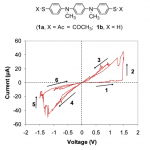 “Reversible bistable switching in nanoscale thiol-substituted oligoaniline molecular junctions”, L. Cai, M. A. Cabassi, H. Yoon, O. M. Cabarcos, C. L. McGuiness, A. K. Flatt, D. L. Allara, J. M. Tour, and T. S. Mayer, Nano Letters 5 (12), 2365-2372, 2005.
“Reversible bistable switching in nanoscale thiol-substituted oligoaniline molecular junctions”, L. Cai, M. A. Cabassi, H. Yoon, O. M. Cabarcos, C. L. McGuiness, A. K. Flatt, D. L. Allara, J. M. Tour, and T. S. Mayer, Nano Letters 5 (12), 2365-2372, 2005.
1. Department of Electrical Engineering and Department of Chemistry and Materials Research Institute, The Pennsylvania State University, University Park, Pennsylvania 16802
2. Department of Chemistry and Center for Nanoscale Science and Technology, Rice University, Houston, Texas 77005
ABSTRACT. Single molecular monolayers of oligoaniline dimers were integrated into sub-40-nm-diameter metal nanowires to form in-wire molecular junctions. These junctions exhibited reproducible room temperature bistable switching with zero-bias high- to low-current state conductance ratios of up to 50, switching threshold voltages of approximately ±1.5 V, and no measurable decay in the high-state current over 22 h. Such switching was not observed in similarly fabricated saturated dodecane (C12) or conjugated oligo(phenylene ethynylene) (OPE) molecular junctions. The low- and high-state current versus voltage was independent of temperature (10-300 K), suggesting that the dominant transport mechanism in these junctions is coherent tunneling. Inelastic electron tunneling spectra collected at 10 K show a change in the vibrational modes of the oligoaniline dimers when the junctions are switched from the low- to the high-current state. The results of these measurements suggest that the switching behavior is an inherent molecular feature that can be attributed to the oligoaniline dimer molecules that form the junction.

